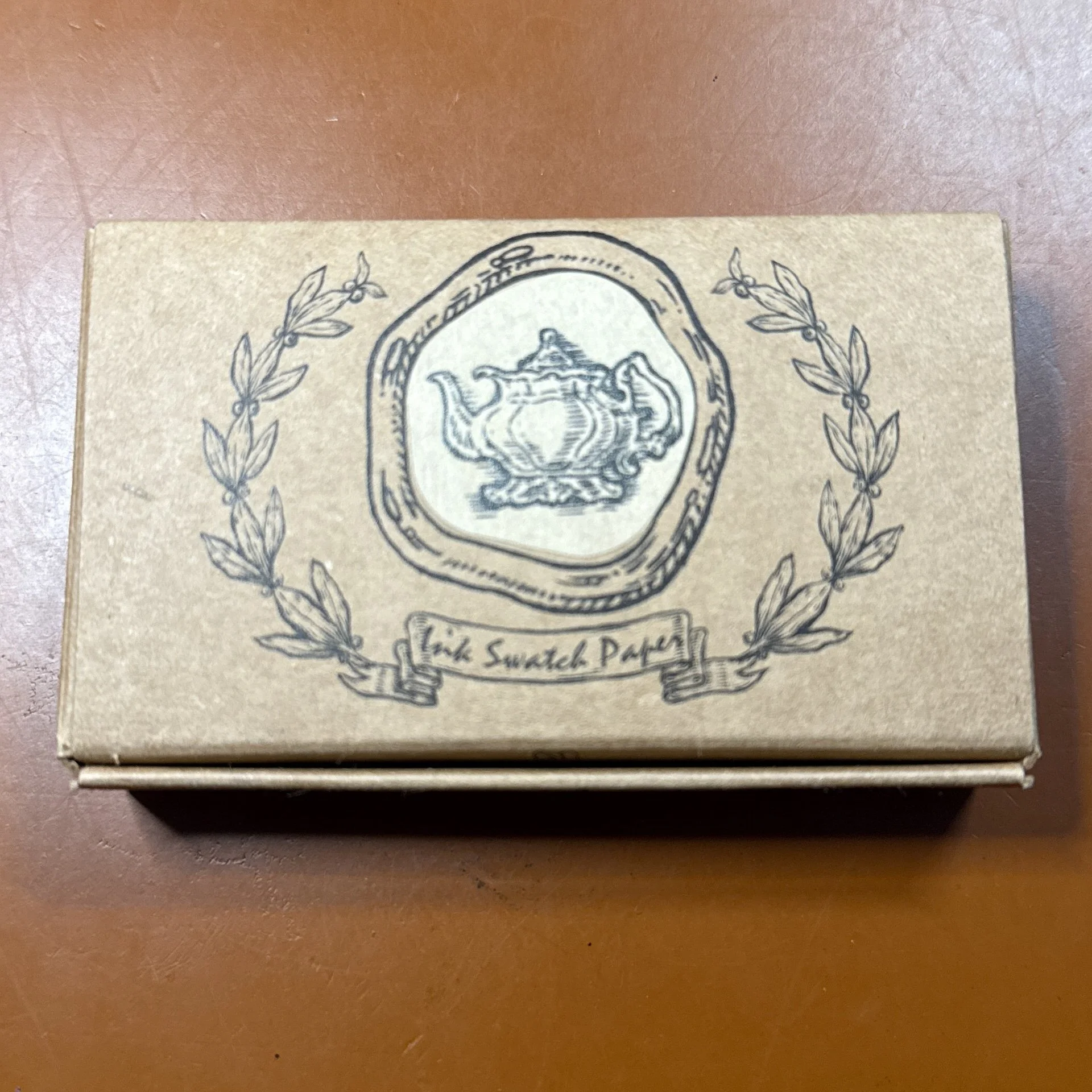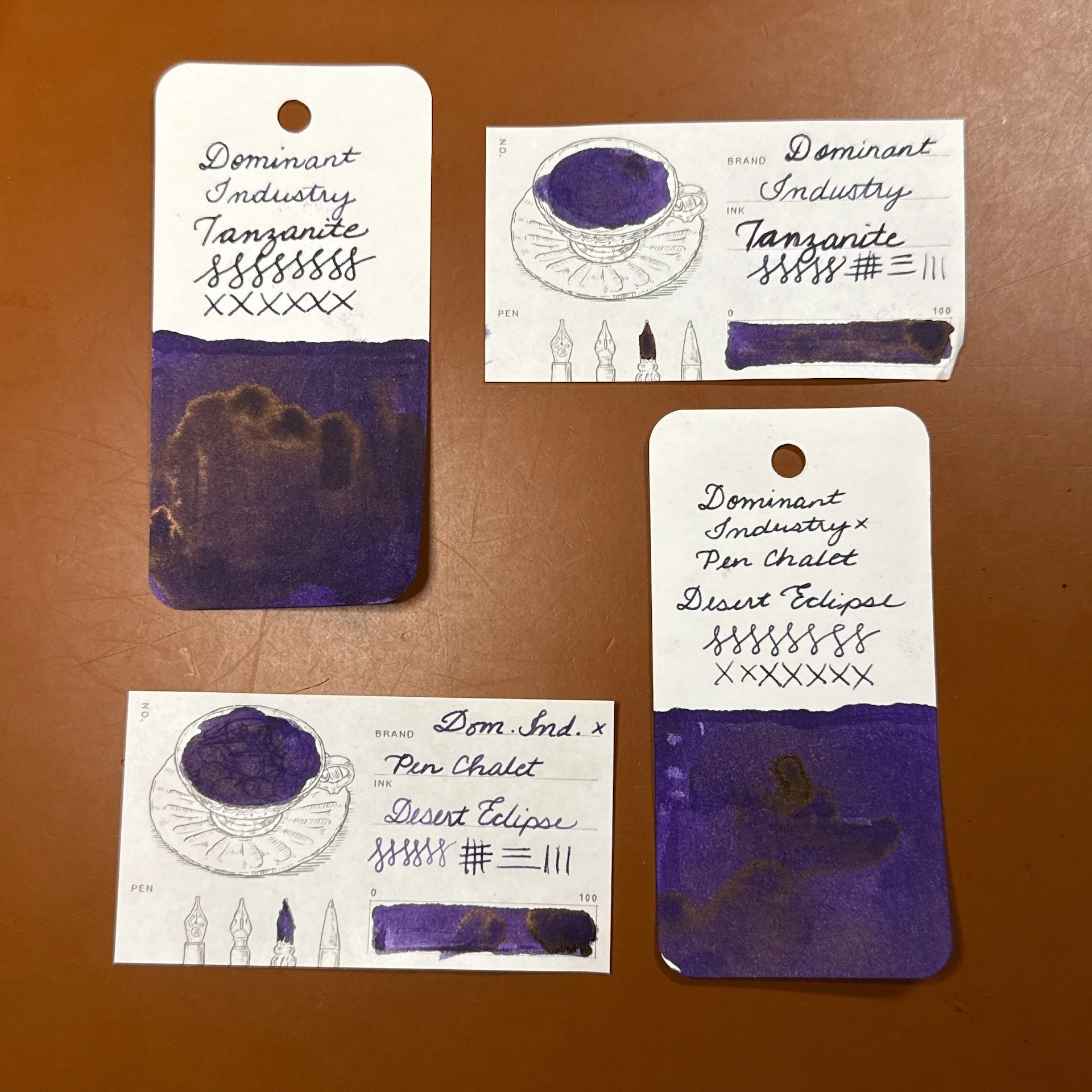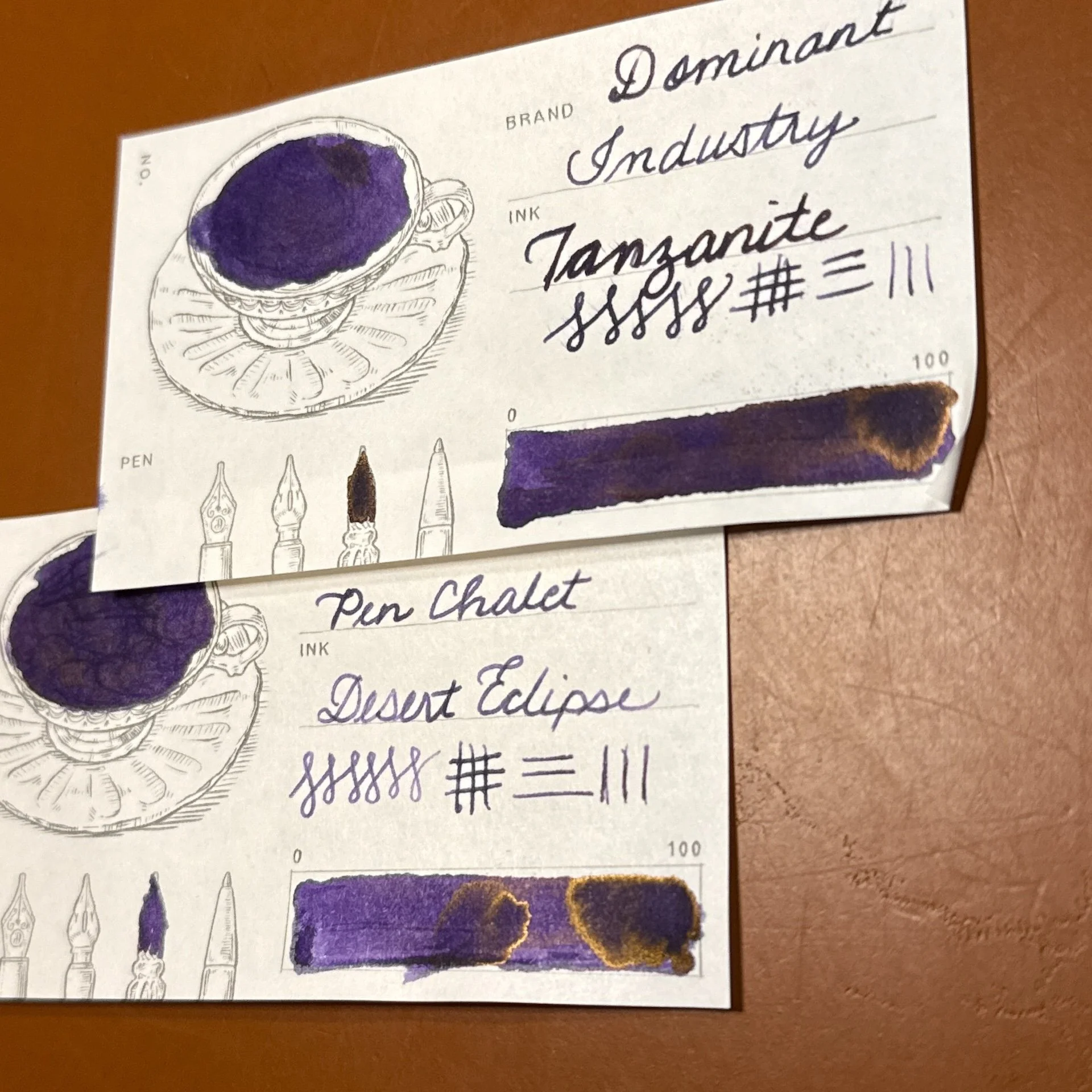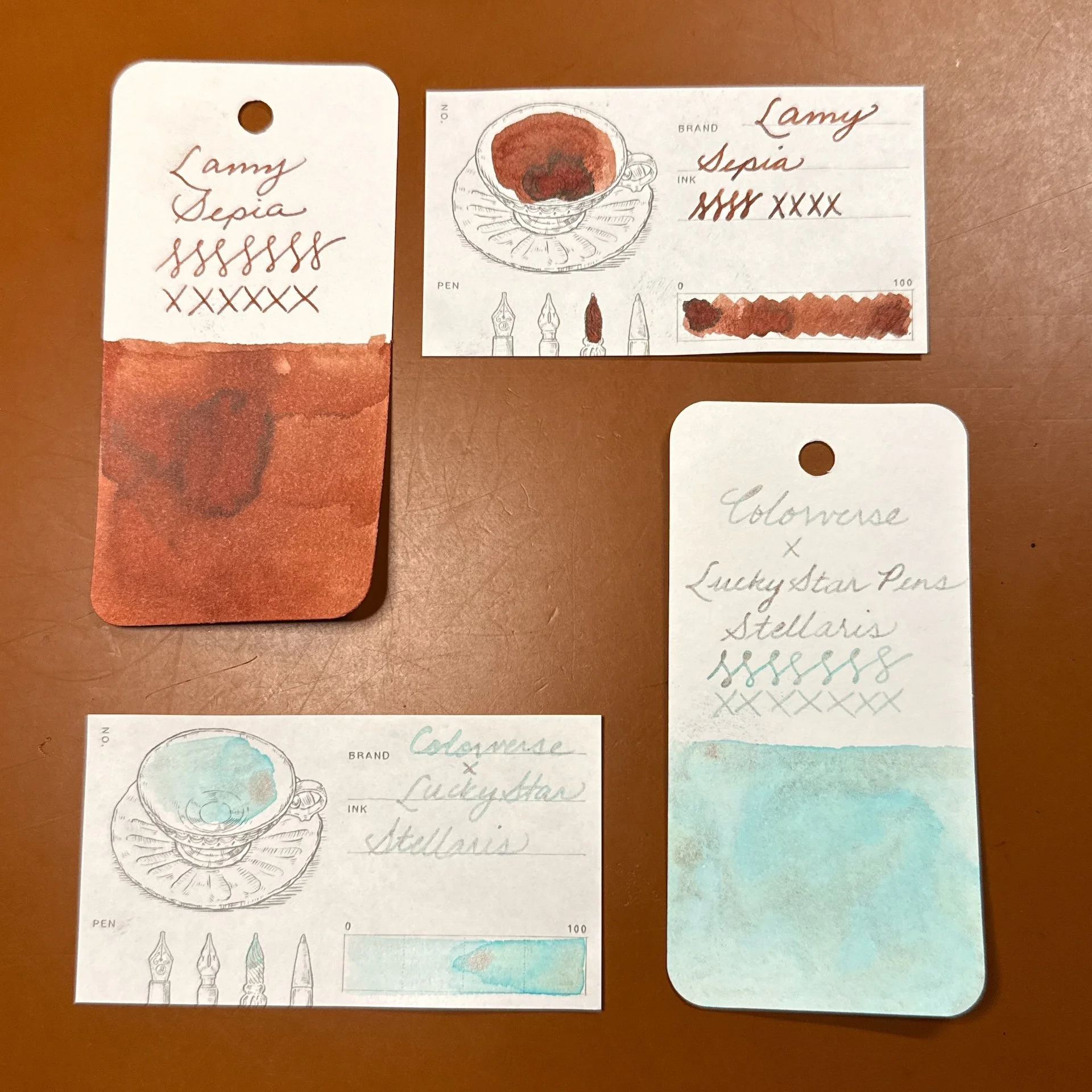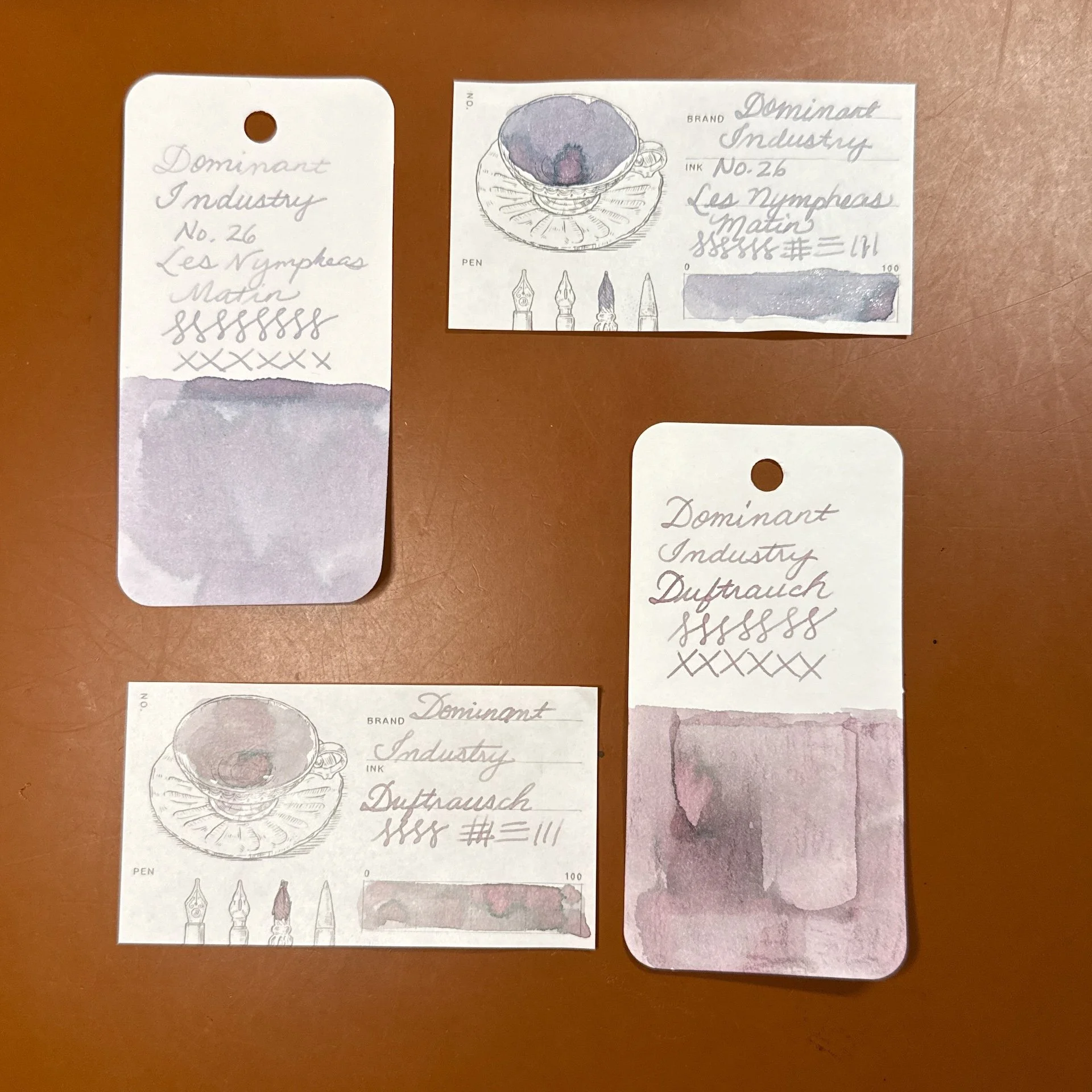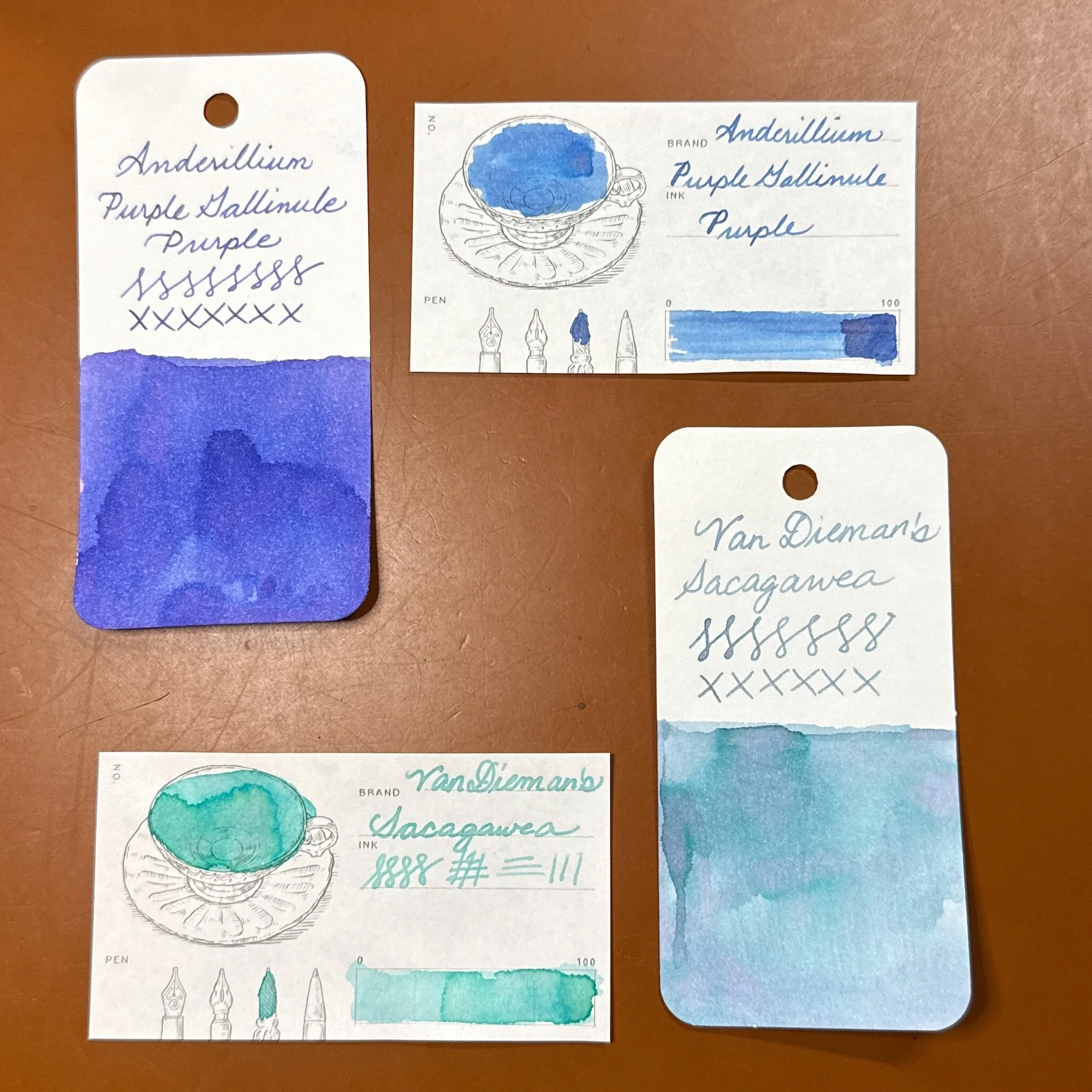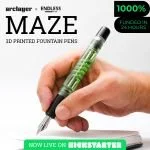(Kimberly (she/her) took the express train down the fountain pen/stationery rabbit hole and doesn't want to be rescued. She can be found on Instagram @allthehobbies because there really are many, many hobbies!.)
As if I needed more ways to swatch my inks, I couldn’t pass up the opportunity to try the swatch paper from Dominant Industry. The Dominant Industry Takasago Ink Swatch Paper measures 2” x 3.5” or 50 x 90 mm and comes in 3 designs of 40 cards each, packaged in a small cardboard case. Note that the packaging doesn’t say “swatch cards”, that’s just what I’m calling them in this review.
Box of Dominant Industry Takasago Paper ink swatch cards.
This is the Tea Time set - with 3 different designs.
Each one has a teacup image on the upper left, designs of writing tips on the bottom left (fountain pen, dip pen, glass dip pen, marker or pencil - not sure what the fourth one is, to be honest), space for Brand and Ink names, and a bar with 4 segments to color in as you see fit.
Testing notes:
- I used the Stainless Steel Kakimori dip nib in my trusty Kaweco clutch pencil holder to make the swatches and writing samples.
- I used the DI swatch cards and Col-o-Ring cards (my go-to for swatch cards) for comparison.
- I did not rinse the nibs while swatching the same ink on different cards/paper. I definitely rinsed after I was done swatching each color.
- For the bottom right bar, I swatched from left to right to fill the whole space, then dabbed extra ink on the second half of the bar to make it darker.
I started out staying on brand and swatching some Dominant Industry inks.
DI Tanzanite (top) and Pen Chalet exclusive Desert Eclipse. Both are very similar dark purples with a bit of copper sheen, with Tanzanite being a touch darker. DI swatches are similar to Col-o-Ring.
You can see that the DI cards also show some of the copper sheen.
Two more DI x Pen Chalet inks: Arizona Sky Crimson (top) and Arizona Sky Citrus. (bottom) Both DI cards are similar to Col-o-Ring.
The cards are made from Takasago 87.9 gsm paper which happens to be the same weight as #5 in the Yamamoto Fountain Pen Friendly Paper Collection Vol. 7, but I can’t tell if they are exactly the same or not. The paper is very smooth to write/swatch on, and while it’s very thin, there was minimal ghosting and zero bleedthrough.
I wanted to make sure that the DI cards also worked well with other inks, so I swatched a few other brands too.
Lamy Sepia (top) and Colorverse x Lucky Star Pens Stellaris (bottom) - Both matched the Col-o-Ring. Sepia is a “straightforward” red-brown ink with a little bit of shading, while Stellaris has copper/rose gold shimmer, which showed up in both swatches. It also shows the turquoise outlines in the darker parts of the swatch.
I can go on with the various inks that matched the swatches on the Col-o-Ring, but what fun is that? There were other inks where the swatches were similar but a little bit off. Here are some examples:
Dominant Industry Les Nympheas Matin (top) and Duftrausch (bottom) Nympheas is pretty similar on both the Col-o-Ring and the DI card, with the card showing a touch more purple, and the Dufrauch showing more pink on the Col-o-Ring vs a little more grey on the DI card.
This isn’t as easy to see in the pictures, but Anderillium Pompadour Cotinga Burgundy (top) is browner on the DI card than Col-o-Ring (which had some water drops resulting in bright pink spots). On the bottom, Anderillium Roseate Spoonbill Pink is a lighter pink in both the DI writing sample and the swatch. Only when I went over the same part of the bar multiple times, was the pink as dark as the Col-o-Ring writing or swatch.
Then there were some swatches that had me questioning whether I swatched the right ink or wrote down the right name and yes, I double-checked and it was not a mistake.
Anderillium Purple Gallinule Purple (top) is practically blue on the DI swatch card, while being somewhere between blurple and purple on the Col-o-Ring. You can also see some of the purple peeking out on the DI swatch card. The Van Diemena’s Sacagawea is a gorgeous dusty blue/teal/purple chromashader with a bit of shimmer on the Col-o-Ring card but is a mint green with a hint of light pink/grey.
Lest you think this must be a chromashading issue, there were no problems with these two chromashaders that I happened to swatch today either. There were also no problems with other inks from those brands.
Wearingeul Enki (top) on Col-o-ring, Wearingeul Instant Film Color Swatch card and DI card - you can see the subtle purple shading on all 3 of these swatch cards. Ditto for this gorgeous chromashader Mung Shing by Hosia Ink Studio.
I swatched 22 inks on the DI and Col-o-ring cards and really only had 2 inks look drastically different on the DI card, and maybe 4 that were a little different. Needless to say, as with any paper and ink combo, your mileage may vary with some inks swatching the same on the DI cards as other cards/paper. I won’t bore you with additional photos, but I compared my Col-o-Ring swatches to swatches done in my Hobonichi Weeks (52 gsm Tomoe River paper) and Endless Recorder (68 gsm TR) and they were what I expected, so it was really the DI Takasago paper for a few of these inks that was the differentiator.
As I mentioned earlier, this is a thinner paper so I don’t think it would hold up as well to the constant flipping that I subject my Col-o-Ring cards to. I would definitely put them in a binder to protect them.
A pack of 120 sheets of the Dominant Industry Takasago Ink Swatch Paper retails for $13.00, but you can often find it for less. It is a cute way to swatch your inks as long as you are aware that some inks might look different on other papers.
(Disclaimer: The Dominant Industry Takasago Ink Swatch Papers were purchased at a discount from sponsor Pen Chalet. Lamy Sepia and Anderillium inks were from past reviews. All other inks (including the DI inks) and Col-o-Ring are my own.)

